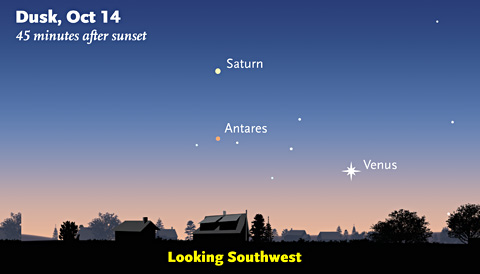Download our monthly astronomy podcast to track down Saturn in the evening sky one last time. Mars is still hanging around, and Venus is climbing higher each evening.

Sky & Telescope diagram
In this month's astronomy podcast, you'll scan the western horizon after sunset for not one but three major planets. Saturn will soon be bowing out, Mars is lingering low in the west, and Venus is climbing higher and becoming more apparent each week.
Meanwhile, over in the east, keep an eye out for a big square of four stars that mark the body of Pegasus, mythology's famous flying horse. But why is Pegasus flying upside down — and where's its back half?
Swing your gaze northward, and you'll find the Big Dipper low down and the stars of Cassiopeia high up. In between lies Polaris, the North Star.
For more skywatching tips for October — including how to spot Jupiter and Mercury paired closely together in the predawn sky — listen to or download our monthly astronomy podcast below.
Podcast: Play in new window | Download
Subscribe: Apple Podcasts | Google Podcasts | Spotify | Email | RSS | More
 1
1
Comments
September 30, 2016 at 7:17 pm
The Right Ascension of the Big Dipper's "Pointers" are 11h 03m (Dubhe) and 11h 01m (Merak)
The Right Ascension of the 2 western stars in the Great Square of Pegasus are 23h 03m (Sheat, in the NW "corner") and 23h 04m (Merkab, in the SW "corner"), 12 hours in Right Ascension away from the "Pointers".
This means:
1. Like the "Pointers", a line from Merkab through Sheat points to Polaris.
2. If you continue that line past Polaris, it will take you to the Pointers, low in the Northwest in the early autumn evenings.
You must be logged in to post a comment.
You must be logged in to post a comment.